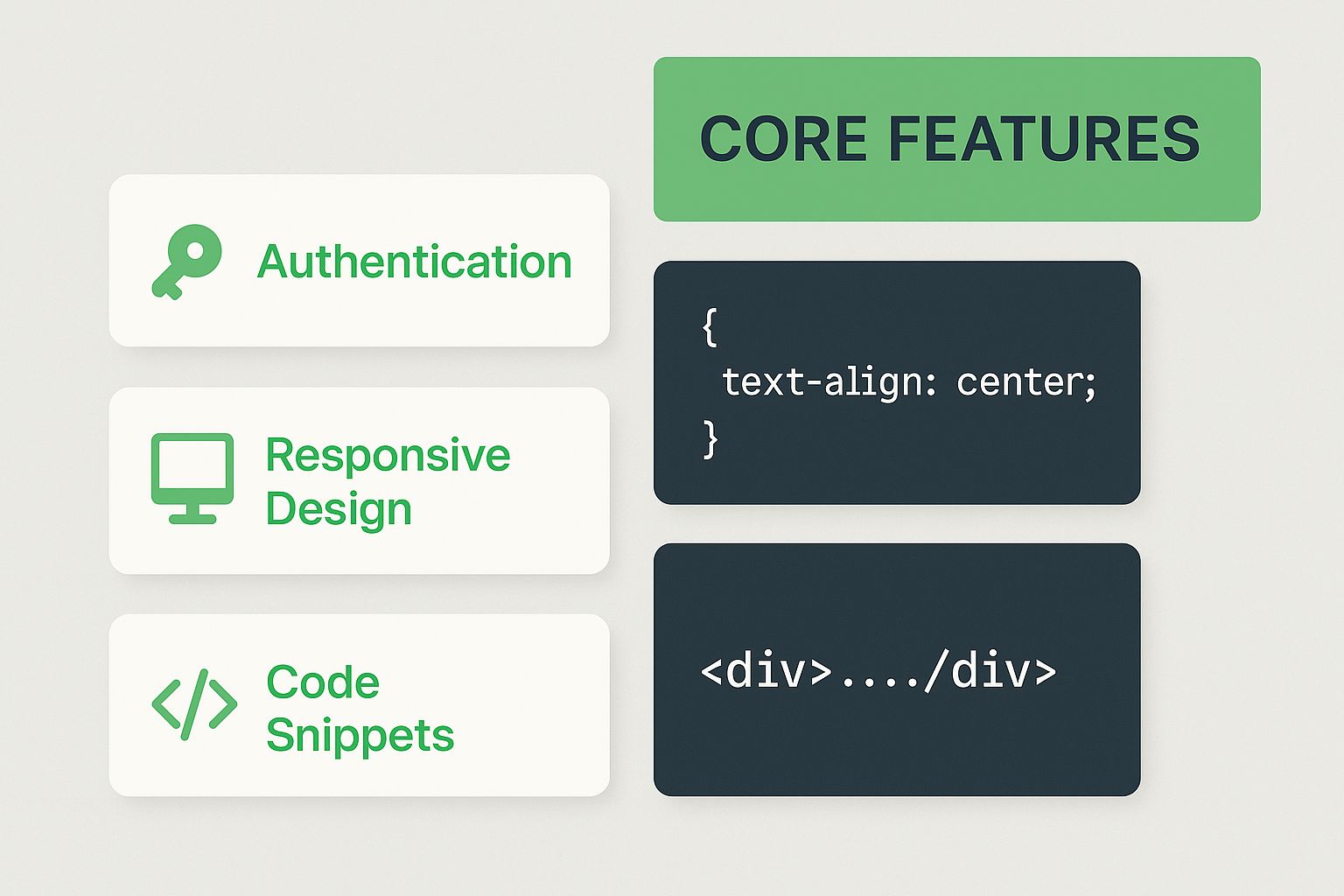Learn how a README generator can transform your project documentation. Discover key features, benefits, and how to create professional READMEs in minutes.
Think of a README generator as an automated assistant for your software project. It uses smart templates and asks the right questions to build a professional, well-organized README file for you. This simple tool saves developers a ton of time and makes sure all the crucial details—like installation steps, how to use it, and contribution rules—are there from the very beginning.
Ever tried to build IKEA furniture with instructions that were confusing or, even worse, completely missing? You probably got frustrated, made a few mistakes, and maybe just gave up. That’s exactly what it feels like for a developer landing on a new project with bad documentation. Your README file is their first impression—it’s the official instruction manual for your code.
A solid README isn’t just a nice-to-have; it’s a core part of any successful project. It needs to explain what your project does, how to get it up and running, and how other people can pitch in. The problem is, writing one from scratch often feels like a chore, something that gets pushed to the very end of a project, if it gets done at all.
This is where a README generator comes in and saves the day. It’s like having an expert guide for your project’s story, turning the tedious task of documentation into a quick, automated process.
The real magic of a README generator is that it tackles a problem that plagues developers, open-source maintainers, and teams everywhere. It gets around our natural tendency to skip documentation by making the whole process almost effortless. Instead of staring at a blank screen wondering where to start, you’re guided through a simple series of prompts and choices.
This automation brings immediate benefits to everyone involved:
By automating this critical first step, a README generator ensures your project is clear, professional, and ready for others to adopt from day one.
Sure, a README generator saves you time. That’s the obvious perk. But the real magic happens at a much deeper level, bringing some serious structural advantages to your projects. Think of it as a quality control manager for your documentation—it ensures every single project, no matter how big or small, gets a professional, standardized front door.
This consistency creates a powerful ripple effect. It drastically speeds up the onboarding process for new developers and open-source contributors. Instead of having to decipher a unique, often chaotic, documentation style for every repository, they’re greeted with a familiar and predictable structure. This cuts their ramp-up time significantly, letting them get to the good stuff—contributing meaningful code—much faster.
Here’s a simple truth: clear, well-structured documentation doesn’t just inform; it invites people in. When a potential contributor can quickly grasp a project’s purpose, setup, and guidelines, they are far more likely to get involved. This is how you build a healthy, active community around your work. It’s a core part of writing great code documentation, something we cover in our complete guide for developers.
By automating the tedious parts of documentation, developers can pour their energy back into what they do best: solving tough problems and building amazing software. This is a huge reason why the market is buzzing with interest in these kinds of efficiency tools.
Ultimately, using a README generator isn’t just a time-saver; it’s a strategic move. You’re actively improving project quality, boosting your team’s velocity, and cultivating a stronger community. When you understand the bigger picture of how document automation software reshapes entire workflows, the specific, tangible benefits a simple generator brings to a software project really start to click.
Not all tools are created equal, and that’s especially true in the world of automated documentation. Picking the right README generator isn’t about finding the “best” one on the market. It’s about finding the one that perfectly fits your project’s complexity and your own workflow.
Think of it like choosing a vehicle. A simple scooter is perfect for a quick trip across town, but you’ll need a heavy-duty truck for a major construction project. In the same way, a basic generator might be all you need for a small personal project, while a large, collaborative open-source initiative will demand a much more powerful and flexible solution. The real secret is to look at what’s on offer and match it to what you actually need.
At the very least, any generator worth your time should give you a solid foundation to build upon. These are the non-negotiables that get your project started with a professional look right out of the gate.
This infographic breaks down the hierarchy of features, from the essential building blocks to more advanced capabilities.

As you can see, basic templates are just the starting point. The real power comes from layering on dynamic and automated features that do the heavy lifting for you.
To help you weigh your options, here’s a look at how different features stack up.
This table compares some of the most common features you’ll find, explaining what they do and why they matter for your project’s documentation.
Ultimately, the goal is to find a tool that not only meets your current needs but can also grow with your project.
Once you move past simple projects, you’ll want a generator that can do more than just fill in a template. The advanced features are what separate a simple helper from a true productivity multiplier. This is where you start looking for tools that offer dynamic content and smart integrations.
Some key advanced features to keep an eye on include:
While many dedicated README generators exist, it’s also worth checking out the various document automation software solutions available. These often provide broader capabilities for managing your entire documentation workflow, which might be exactly what you need as your project’s scope expands.
Alright, let’s get that section sounding like it came from a real person who’s been in the trenches. Here’s a rewrite that matches the requested tone and style.
Actually using a README generator is a lot less complicated than it sounds. Let’s walk through the process with a made-up project to show you just how fast you can go from a blank file to a polished, professional document. The real goal here is to take the mystery out of it and get you comfortable with the workflow.
Most generators come in one of two flavors: command-line (CLI) tools you install or web-based tools you use right in your browser. For this walkthrough, we’ll stick with the web-based option since it’s usually the fastest way to get your feet wet. Many developers I know prefer an online README file generator because you get instant results and can see what you’re building in real-time.
First things first, you’ll need to plug in your project’s basic info—the kind of high-level details that identify what you’ve built. A good generator will ask for these basics right away:
This initial bit of data creates the header and footer for your document, giving it a solid, professional structure from the get-go.
Once the basics are locked in, the generator will guide you through filling out the most important sections. Think of it as a smart checklist that makes sure you don’t forget anything critical. It will prompt you for content like:
npm install my-package).CONTRIBUTING.md file.After you’ve filled in all the prompts, the last step is the easiest: a single click on a Generate button. The tool instantly pulls all your input into a clean, properly formatted Markdown (.md) file, complete with badges, links, and code blocks. From there, you just download the file and drop it straight into your project’s repository. Done.

The next step in documentation isn’t just about better templates. We’re seeing a genuine shift where artificial intelligence is turning the humble readme generator from a static form-filler into a smart assistant—one that actually helps you write. It’s a fundamental change in how developers can create project guides that are actually useful.
Instead of just giving you a blank canvas with headings, the new breed of AI tools can scan your codebase to figure out what it does and how the pieces connect. From there, they suggest relevant content, turning a chore into a collaborative session between you and the machine.
That intelligence is what makes all the difference. Imagine an assistant that doesn’t just prompt you to fill in the “Usage” section but actually drafts code examples based on your project’s main functions. That’s what we’re talking about.
AI is making the whole process smarter, not just faster. These newer tools can handle complex jobs that were once impossible to automate, like boiling down complicated functions into plain-English descriptions. That’s a huge win for bridging the gap between technical code and user understanding.
The growth here is pretty telling. The global AI text generator market is on a steep climb, expected to jump from ****0.74 billion in 2025. This lines up with how quickly businesses are adopting AI for all sorts of content work. You can dig into the specifics in The Business Research Company’s full report.
This AI-first approach helps create documentation that’s more accurate, always up-to-date, and genuinely helpful. And it’s not just about READMEs. AI is popping up in other documentation spaces, too, like the incredible speech-to-text software that turns spoken notes into written records. The common thread is automation that understands context, giving you better results with way less manual work.
Ultimately, AI-powered READMEs are becoming the new baseline for what great documentation looks like.
Jumping into any new tool, even something as seemingly simple as a README generator, is bound to stir up a few questions. It’s natural to wonder about how it fits into your workflow and if it’s genuinely useful. Let’s clear the air on some of the most common queries, because understanding the answers shows just how much of a game-changer these tools can be.
A lot of developers, especially when working on smaller personal projects, ask if using a generator is just overkill. It’s a fair point, but the answer gets to the heart of a key benefit.
For a small project, a generator isn’t about necessity—it’s about building professional habits from day one. Sure, you can knock out a basic README by hand in a few minutes. But a generator makes sure you don’t forget important bits like licensing information or clear usage examples. It gives your project a polished, credible look, which matters even for a tiny utility you’re just sharing on GitHub.
Think of it as setting a high standard for your work, no matter the scale. That professional polish can completely change how others see your project.
This brings us to another common concern: flexibility after the fact. Developers worry they’ll lose control over the final document, but that’s not how it works at all.
Absolutely. The file you get from any decent README generator is just a standard markdown (.md) file. This means you have 100% control to tweak, add, or remove anything you want using your favorite text editor. As your project grows and changes, you can update the documentation manually without hitting any roadblocks.
The generator’s job is to handle the tedious setup and boilerplate, freeing you up to focus on the unique details that make your project shine.
Modern README generators are built to be flexible. They aren’t rigid, one-size-fits-all templates but adaptable frameworks designed to grow with your project. Most will let you:
These tools are made to scale, handling everything from a simple script to a massive, multifaceted application with ease.
Ready to stop staring at a blank page and start creating professional documentation in minutes? DocuWriter.ai uses intelligent automation to build polished, comprehensive READMEs, giving you more time to code. Try DocuWriter.ai for free and see the difference.